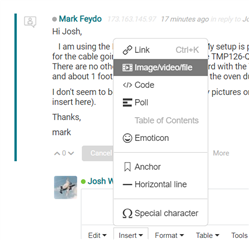Hi,
I have connected the TMP126-Q1 to my development system and am testing it. Everything is working as expected at ~room temperature. Today I put the sensor in a industrial oven to check it's operation at high temperature. The over is set to 150 degrees C (and I have verified this is the actual temperature using a Fluke Temperature meter with thermocouple attached). In the first several readings after inserting your device in to the oven I see the temperature rising and then the temperature reading from the chip drops to a very low value (0x0080 and 0x00CC seem to be most common). If I then remove the chip from the oven it "recovers" and I can watch the temperature fall back to room temperature.
I have tried with two devices and both are behaving exactly the same. My system is setup to take one reading every 20 seconds. The highest temperature I have seen is 114C and by the next reading the low value reading is present.
So, a couple questions:
1) Does the device really work to 175C as stated in the datasheet? Is there anything special I need to do to get it to work at maximum temperature?
2) What is the expected behavior of the part when the temperature exceeds 175C? Is there any way to know if I have went above the temp limit of the chip?
3) I see this part is now out of stock. Any idea when more will be available ... should I continue to plan on using it in my soon to be released product or is it many months / years away?
Thanks,
mark


